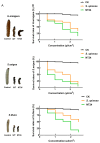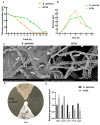ARTP/NTG Compound Mutagenesis Improved the Spinosad Production and the Insecticidal Virulence of Saccharopolyspora Spinosa
- PMID: 39596372
- PMCID: PMC11594378
- DOI: 10.3390/ijms252212308
ARTP/NTG Compound Mutagenesis Improved the Spinosad Production and the Insecticidal Virulence of Saccharopolyspora Spinosa
Abstract
Spinosad is an efficient and broad-spectrum environmentally friendly biopesticide, but its low yield in wild-type Saccharopolyspora spinosa limits its further application. ARTP/NTG compound mutagenesis was used in this study to improve the spinosad titer of S. spinosa and obtain a high-yield mutant-NT24. Compared with the wild-type strain, the fermentation cycle of NT24 was shortened by 2 days and its maximum titer of spinosad reached 858.3 ± 27.7 mg/L, which is 5.12 times more than for the same-period titer of the wild-type strain. In addition, RT-qPCR, resequencing, and targeted metabolomics showed that the upregulation of the key differential genes accD6, fadD, sdhB, oadA, and gntZ caused increased metabolic flux in the tricarboxylic acid cycle and pentose phosphate pathway, suggesting that the accumulation of pyruvate and short-chain acyl-CoA was the primary cause of spinosad accumulation in NT24. This study demonstrates the effectiveness of ARTP mutagenesis in S. spinosa, and provides new insights for the mechanism of spinosad biosynthesis and metabolic engineering in S. spinosa.
Keywords: ARTP/NTG mutagenesis; Saccharopolyspora spinosa; biotechnology; spinosad.
Conflict of interest statement
The authors declare no conflicts of interest.
Figures







References
MeSH terms
Substances
Supplementary concepts
Grants and funding
LinkOut - more resources
Full Text Sources

